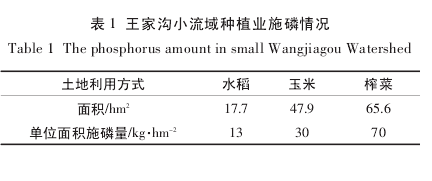摘要:于 2012 年 3 月 21 日-2013 年 3 月 20 日期间对三峡库区涪陵段两个毗邻集水域汇出口径流水质进行了高频(每日)采样监测,以对比分析稻田空间分布格局对径流磷浓度和输出强度的影响。两集水域气候地理条件相似,农耕方式相同,单位面积施肥量相近,但其中一个(记为集水域 A)稻田分布零散,破碎度高,而另一个(集水域 B)稻田连片分布在其末(底)端,破碎度低。结果显示,集水域 A 在全年和不同作物生长季的径流总磷平均浓度都相应地高于集水域 B.同样,前者的径流产流量(1431 m3·hm-2·a-1)也显着高于后者(840 m3·hm-2·a-1),因而前者径流总磷的年输出通量(210 g·hm-2·a-1)远大于后者(72 g·hm-2·a-1)。按季节计算,两集水域水稻/玉米季总磷浓度皆高于榨菜季,集水域 A 在水稻/玉米季的径流总磷输出通量(147 g·hm-2·a-1)是榨菜季(63 g·hm-2·a-1)的1.9 倍,集水域 B 在水稻/玉米季的径流总磷输出通量(58 g·hm-2·a-1)是榨菜季(14 g·hm-2·a-1)的 3.6 倍。从研究中看,这些差异很有可能是两集水域的土地利用,特别是水稻田布局差异所导致的,因此实现水稻田的合理布局是三峡库区径流磷排放负荷减控的有效措施。
关键词:三峡库区;面源污染;农业小流域;磷。
Abstract:A high frequency(daily)monitoring campaign was carried out in two adjacent catchments in Fuling of the Three Gorges Reservoirfor one whole year with the aims of analyzing comparatively the impact of spatial distribution pattern of rice paddies on phosphorus(P)con-centration and export fluxes in runoff. The two catchments were subjected to the same climate conditions, tillage and cropping practices, andreceived the equivalent fertilization rates in terms of per unit of land area. Nevertheless, the rice paddies in one catchmen(tmarked A)werescattered and higher in fragmentation index, and those in the other(marked B)were mainly distributed at the bottom of the catchment andlower in fragmentation index. Comparing the two catchments, the average runoff concentration of total P in A was correspondingly higherthan that in B all over the year and in the different crop growing seasons. Similarly, the amount of runoff from the outlet in A(1431 m3·hm-2·a-1)was significantly higher than that in B(840 m3·hm-2·a-1)。 As a result, the total P export flux from A(210 g·hm-2·a-1)was muchhigher than that from B (72 g·hm-2·a-1)。 For both the catchments A and B, the runoff P concentration during the rice/maize season far ex-ceeded that of the mustard season, and the total loss of runoff P during the former season was 1.9 and 3.6 times higher than that of the latterseason, respectively. The differences in the runoff concentration and loss of P between the two studied catchments might be attributed to thedifferent spatial distribution patterns of the rice fields within them. This indicates that the reasonable configuration of rice paddies can serveas an effective measure to reduce runoff P discharge in the Three Gorges Reservoir Area.
Keywords:Three Gorges Reservoir; non-point source pollution; agricultural watershed; phosphorus.
自三峡水库蓄水以来,水环境变化显着,水体富营养化现象日趋严重[1-2].农业生产是三峡库区农民经济收入的重要来源,该区域大部分地区化肥年平均施用量超过了 500 kg·hm-2[3],高于国内平均水平(375kg·hm-2)[4].大量研究表明,化肥的过量施用是造成农田氮磷流失的重要原因,导致三峡库区水环境日益恶化[5-7].目前,关于三峡库区非点源污染氮磷流失的定量化研究大多还是关于暴雨径流、短期连续采样[8-9]或以周、月为单位的间断性采样[10-12]的研究分析,具有频率低、季节单一或时间短等不足。
磷是水体富营养化的限制因子[13],主要集中于耕层,垂直下移程度很小,雨水冲刷和地表径流被认为是磷素流失的主要途径[14-16].有研究表明,径流量与营养物质输出呈显着相关性[17-18],特别在径流系数较高的山地丘陵这种现象更加突出[19].但影响农田氮磷流失的因素是多方面的。洪林等[20]在丘陵地区的工作与马传功等[21]的研究都发现,不同的耕作模式对地表氮磷流失量有较大影响,并随降雨强度增加而呈增加的趋势;黄东风等[22]发现,施肥和灌溉的有效搭配可以减少稻田地表径流的氮、磷流失量。这些研究主要针对的是不同耕作模式以及各类型土地利用面积比例对流域内氮磷负荷输出影响[18,22],对另一个可能造成影响的因素---稻田空间分布格局却鲜有提及。已有研究发现[23],稻田种植面积比例对流域内径流水质有显着的影响。杨丽霞等[24]指出,稻田径流发生时间与施肥时期的间隔是决定径流磷素损失的重要因素。由此可见,稻田的存在会对流域内氮磷负荷的输出产生一定的影响。本研究选择三峡库区涪陵段王家沟小流域内两个具有相同气候、土壤耕作环境,却在稻田空间分布格局上迥异的毗邻集水域为研究对象,对两集水域汇出口径流水以及降雨进行连续一年、每日一次的高频采样监测,以期更准确地掌握集水域内径流总磷浓度动态变化以及累积排放负荷,为三峡库区农业非点源污染治理提供参考。
1 材料与方法。
1.1 研究流域概况。
重庆涪陵珍溪镇王家沟小流域(29°54′N,107°27′E),地处涪陵东部,长江北岸,上距涪陵城区约 30km,下距丰都城约 46 km,在三峡库区的腹心位置,系亚热带湿润季风气候,四季明显,多年平均气温 22.1℃,雨量充沛,平均降雨量 1011 mm.地形为低山丘陵地,海拔高度范围 153~307 m.流域内坡度在 40°以下,大部分区域都在 20°以内,少数地区在 20°~40°范围变化。土壤为侏罗系蓬莱镇组棕紫色砂泥岩相发育的棕紫泥,pH 5.6~8.1,养分除钾含量较高外,其余有机质、有效养分含量均为中等,但微量元素含量低,属中度缺乏。流域内分布有自然村落,无工矿企业,农业以人工耕作方式为主,微型机械耕作为辅,主产水稻、玉米和榨菜,构成了具有多种土地利用格局的农业生态系统。每年的土地利用方式和生产方式稳定,化肥施用是流域农田磷素输入的主要来源,平均输入 P 约86.6 kg·hm-2·a-1,占总输入的 82.9%.每年 3 月底到 5月中旬(玉米、水田栽种季)和 10 月初(榨菜栽种季)是该流域施肥期,具体情况如表 1.
